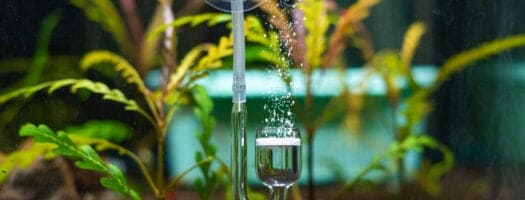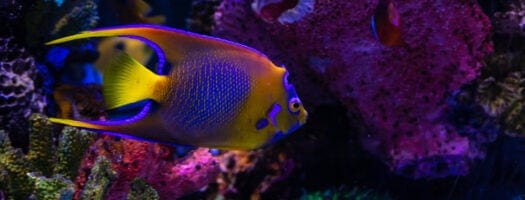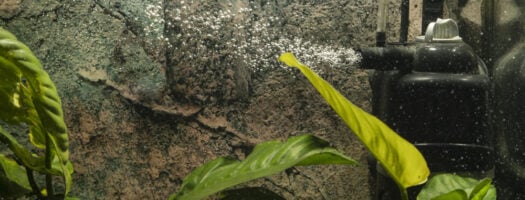The 10 Best Koi Pond Filters in 2025
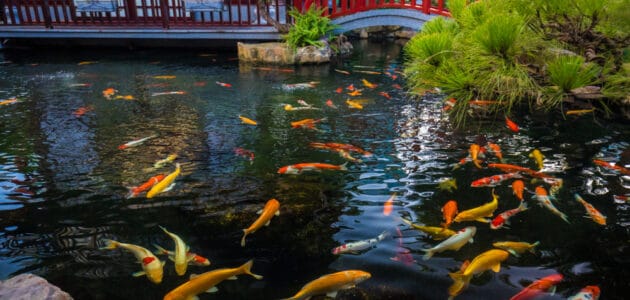
A koi pond can be a relaxing slice of nature to have in your yard. If you’re thinking of getting a koi pond for your backyard, or if you already have one, you should know that keeping it well-maintained is of utmost importance.
This is what makes a filter such an important piece of equipment for pond setups. But if you’re serious about your koi pond and have already begun to delve into the specifics, then you’ve already seen the sheer amount of information that you have to consider. There’s so much out there that one barely knows where to begin.
Fortunately for you, that’s what we’re here for! The following guide contains everything that you have to know when choosing the best koi pond filter to bring out the beauty of your pond.
- Factors to Consider When Buying Koi Pond Filters
- Top 10 Best Koi Pond Filters 2025
- 1. Best Overall Filter: CNZ All in One Pond Filter System
- 2. Best Budget Filter: TetraPond Submersible Flat Box Filter
- 3. Best Premium Filter: OASE BioSmart 5000
- 4. Best Biofiltration Filter: GoPlus Pressure Bio Filter
- 5. Best Pressure Filter: TotalPond Complete Pond Filter With UV Clarifier
- 6. Best Filter for Big Ponds: XtremepowerUS Koi Pond Pressure Bio Filter
- 7. Best Waterfall Filter: TetraPond Waterfall Filter
- 8. Best UV Sterilization Filter: Jebao CF-10 Pressured Pond Bio Filter
- 9. Best Pre-Filtration System: Aquascape Submersible Pond Water Filter
- 10. Most Convenient Filter: Vivohome Bio Pressure Pond Filter
- The Ultimate Guide to Koi Pond Filters
- Getting the Best Koi Pond Filter
Factors to Consider When Buying Koi Pond Filters
Buying the best koi pond filter for your needs isn’t only important for the success of your pond—it’s also a significant financial investment. To make sure that you’re getting the best bang for your buck, we’ve compiled a list of crucial factors that you have to keep in mind when choosing a koi pond filter.
Pond Volume
The size of your pond setup–and consequently, its volume–is a huge determinant of the kind of pond filter that you will get. It will dictate the capacity of the unit, the electrical consumption, and the price.
Ideally, your filter unit should be able to cycle the entire volume of your pond at least once per hour. For example, a 500-gallon small pond needs a filter that can run at least 500 gallons in an hour (or 500 GPH). Meanwhile, a 1500-gallon pond should have a filter that’s at least 1500 GPH at minimum.
Number of Fish
The number of koi fish in your pond is also a huge factor when choosing the best filter for you. After all, the purpose of a filter is to keep the water clean at all times. And the more fish you have, the more dirt and waste that a filter has to work with.
In other words, the more fish you have in your pond, the stronger your filtration system needs to be. Depending on your stocking situation, you may even want to over-filter your pond just to ensure that the water is kept clean the entire time.
For example, if you have a lot of fish crammed together in a 1000 gallon pond, then having a 1000 GPH filter wouldn’t do, as the water would be polluted much faster. You should raise the GPH accordingly to accommodate the density of the waste.
Filter Type
There are many different kinds of filter setups available in the market, with each of them having its own merits and demerits. The basic types are prefilters, pond skimmers, pressure filters, waterfall filters, and UV sterilizers.
There’s no one-size-fits-all when it comes to your pond’s filtration system, so it’s important to pick something that fits the actual needs of your setup. To help you do this, we’ve included a more detailed guide further below.
Location, Size, and Weight
This pertains to the visibility of your filtration system when viewed with the pond as a whole.
Filters are blocky, hefty things. If improperly placed, they can distract from the beauty of your pond-scape. You should think carefully about where you’re planning to put your filter when considering the size, weight, and dimensions of the unit that you want to buy.
Electrical Components
Your filter needs electricity to operate. And since it’s located outside, it’s exposed to elements and other external factors that might cause it some damage. Before you buy a filter unit, think of how protected and safe its electrical components from rain, snow, freeze, or even animals.
Getting a sturdy filter unit with all the right features for outdoor exposure is important when choosing koi pond filters. To help you out, we will discuss the crucial features that you need to look for later in this guide.
With that in mind, let’s get into our list of the ten best koi pond filters you can buy this 2025!
Top 10 Best Koi Pond Filters 2025
1. Best Overall Filter: CNZ All in One Pond Filter System
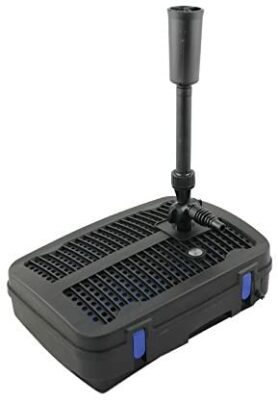
Editor’s Rating:
Why we like it: With the CNZ Pond Filter, you can have thrice-filtered, UV-cleared, crystal-clear pond water in just a few hours – all you have to do is dunk it into the water and plug it into power.
Quick Facts:
- Type: Box-style waterfall filter
- Capacity: 660 GPH
- Filtration stages: Mechanical, biological, and UV
- Includes: FIlter, pump, and UV light
- Wattage: 57W
Overall Performance
Built for small to medium-sized ponds, the CNZ pond filter is a great all-rounder, providing both mechanical and biological filtration as well as a very handy built-in UV sterilizer. This means that not only can it keep your waters clear and toxin-free, it also makes sure that you wouldn’t have to worry about algae and microorganisms ever again – all for a reasonable price.
Features and Setup
This filter is designed for easy setup. Since it already comes with a built-in pump, the only thing that you have to do is submerge it into the water and hook it up to electricity.
Water passes through a large, coarse foam that will provide physical filtration, and then it passes by three media baskets that you can use to fill with whatever biological media that you favor.
Its understated, black-colored design makes it easy to blend into the landscaping of your pond. It can also provide a wonderful waterfall aesthetic as it can lift water at a maximum of 8.2 feet overhead. It has an adjustable flow rate, making it easy to build waterfalls or a fountain. It even includes 3 pieces of fountain attachments and a splitter to add to the spectacle in your pond system.
Downsides
Cleaning the unit can be a bit difficult because everything is built-in. You also have to take the unit apart to service the pump and sterilizer. Since CNZ is also not that well-known a brand, finding replacement parts may be difficult. Thankfully, the product’s quality is top-notch so it’s not likely that you’ll be replacing a lot of parts anyway.
Pros
- Complete filter system
- Includes three baskets for filter media
- Can create waterfall and fountain features
- Easy integration to pond design
- Convenient setup
Cons
- A little difficult to clean
- Replacement parts may not be easy to find
2. Best Budget Filter: TetraPond Submersible Flat Box Filter
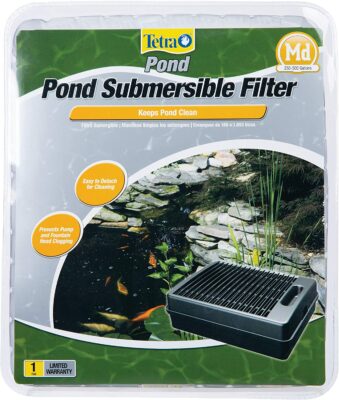
Editor’s Rating:
Why we like it: Although it is a stand-alone filter, the TetraPond Flat Box Filter gives great bang for its buck, clearing your waters without clearing your wallet as well.
Quick Facts:
- Type: Box filter
- Capacity: 200-2000 GPH
- Filtration stages: Mechanical filtration only
- Includes: Filter only
Overall Performance
The TetraPond box filter is a versatile solution for mid- to large-sized pond filtration problems. Its unique build is specifically designed to reduce fountain and pump clogging and fits right into a wide array of many different pond pumps. It’s easy to set up, easy to clean and maintain, and easy to buy replacement parts for.
Features and Setup
Setting up this unit is very easy. Once the pump has been properly attached, water will be sucked into the box filter and will pass through the box filter, where it will be strained by coats and fine mats for unwanted particles. Clean water will then be released back into the pond through your chosen means.
The box includes the filter media and box housing, tubing, and tubing fittings. The filter itself is very versatile and can be attached to a large variety of pumps. You can even replace the filter media with biological filters if you wish to do so.
Although it’s not as thorough as more expensive units like the CNZ Pond Filter, this basic filtration system should be enough to clean up most ponds if you have a limited budget.
Downsides
Admittedly, the filter is rather limited in its capabilities. Options for filter media may be inadequate, and also, since this unit is rather light, there are some reports about the unit not submerging fully for some. Then again, if you’re on a budget, there’s no better filter for your koi.
Pros
- Very affordable
- Versatile use
- Easily blended into the landscaping
- Compatible with a wide variety of pumps
Cons
- Limited filtration
- Inadequate filter media
- Sometimes floats
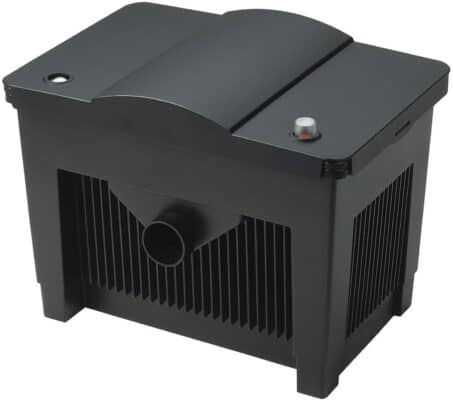
Editor’s Rating:
Why we like it: The OASE BioSmart is not only filled with specialized mechanical, biological, and UV media, it’s also brimming with technological features designed to make pond water filtration smarter, easier, and better.
Quick Facts:
- Type: Non-pressurized, non-submersible box filter
- Capacity: 5000-10000-gallon ponds
- Filtration stages: Mechanical, biological, UV light
- Includes: Filter and UV light
- Wattage: 24W UV light
Overall Performance
OASE’s premium filtration system features unique features designed specifically to keep your mid- to large-sized koi pond healthy and crystal clear. The OASE BioSmart boasts a variety of unique, layered sponge filter media that has different porosity levels designed to catch all kinds of debris and particles that ends up in your pond.
Features and Setup
This filter system includes a temperature gauge, a drainage valve to take care of sludge build-up, and a 24W UV light to sterilize your pond water. The filter itself features easy-clean functions that don’t require you to physically remove the media to remove the muck from it. It also has light indicators that tell you when your media is clogged and needs additional maintenance.
In addition to this, the filter has been dual-optimized to promote the growth of different kinds of beneficial bacteria that breaks down all kinds of organic waste in your pond. Flow rate is also ideal for bacterial growth. Although it isn’t pressurized, it maintains a good, continuous flow essential for the aeration of water.
Downsides
The asking amount does seem a little bit more compared to other brands, but this is a small price to pay when compared to all the nifty things that it can do to make your pond more beautiful and healthy – and your life more relaxing and easy. In terms of hardware build, the intake and outlet portion of the build can be a little flimsy. If you want something more likely to stand the test of time, you might prefer the CNZ All in One Pond Filter System — though it does have fewer bells and whistles.
Pros
- Specialized mechanical and biological filtration
- Easy maintenance and setup
- Excellent water flow
- Ideal for cultivating biological filtration
- Features a lot of useful, extra functions
Cons
- More expensive than counterparts
- Some parts are a little flimsy
4. Best Biofiltration Filter: GoPlus Pressure Bio Filter
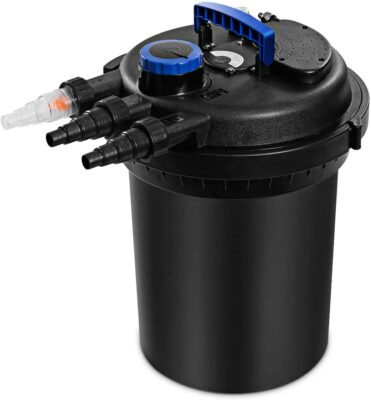
Editor’s Rating:
Why we like it: The Goplus is an affordable premium alternative to big brand-name filters, affording the same handy features that expensive brands have, such as UV sterilization, specialized biological filtration, two-outlet system, and automatic filter cleaning.
Quick Facts
- Type: Pressurized filter
- Capacity: Max 4000 GPH
- Filtration stages: Mechanical, biological, UV
- Includes: Filter and UV light only
- Wattage: 113W UV light
Overall Performance
The Goplus is an all-in-one pressure filter designed with a variety of handy features to make cleaning your large koi pond easy and efficient. It is specifically designed with biological filtration in mind, and it has a built-in UV light to kill microorganisms and keep your water clean.
Features and Setup
The filter is very convenient to set up since the box contains all the necessary fittings. The housing can hook up to different water pipe diameters, and it has a unique dual-outlet design: one outlet directs clean water to the pond, while the other can direct dirty water out of the pond for cleaning. The whole thing is made of high-quality material that will not be damaged by sunlight, exposure, and water.
What makes it easy to maintain is its automatic cleaning function that can clean the filter media without you having to open the container. It comes with specialized two-zone sponge filters. The blue sponges are media that have high flow speeds and support the growth of aerobic bacteria, while yellow sponges offer low flow speeds and support the growth of anaerobic bacteria.
Downsides
Be warned that certain parts of the filter, specifically the housing for the UV light, are not waterproof and may rust the electrical components. This means added effort and expense with waterproofing in mind, especially if you live in an area that sees a lot of snow or rain. The information in the included installation guide is also unclear and incomplete, and customer service is quite unreliable based on user reviews.
Pros
- Affordable compared to leading brands
- Box contains all necessary equipment for set up
- Easy maintenance
- Sturdy filter housing
- Specialized in biological filtration
Cons
- Housing for UV light is not waterproof
- The installation manual is unclear
- Unreliable customer support
5. Best Pressure Filter: TotalPond Complete Pond Filter With UV Clarifier
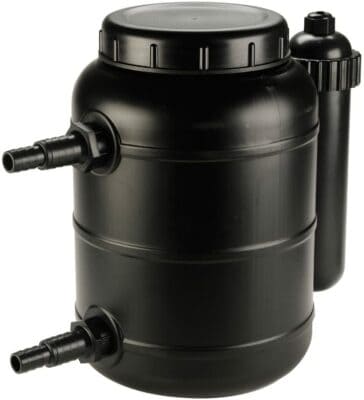
Editor’s Rating:
Why we like it: The TotalPond Complete Pond Filter is a great approach to cleaning up large ponds, thanks to its strong water flow that passes water through a three-stage filtration that ends with a nifty UV clarifier.
Quick Facts
- Type: Pressurized filter
- Capacity: Max 3600 GPH
- Filtration stages: Mechanical, biological, UV
- Includes: Filter and UV clarifier
- Wattage: 9W UV light
Overall Performance
The TotalPond Complete Pond Filter is a reliable piece of equipment that’s suitable for mid- to large-sized ponds. It’s pressurized, meaning it can accommodate high-speed, continuous, strong water flow that won’t let debris settle into the bottom of your pond.
Features and Setup
This filter passes pressurized water into coats and fine media to remove unwanted particles out of the water and cycles it through bio balls that house beneficial, toxin-eating bacteria. In terms of aesthetics, its understated black design makes it easy to hide in the landscape of your pond. The pump, which doesn’t come with this package, can be submerged in water or housed outside of the pond.
It’s versatile enough that you can use it alongside other filters, and you have a wide choice when it comes to choosing pond pumps to attach it with. Although it doesn’t come with a pump of its own, it does have a UV sterilizer that kills other harmful microorganisms in the water.
Downsides
The build quality is quite dubious, which is disappointing considering the price. The housing is made out of thin plastic, making it high-risk for leakages. And despite its name, it’s actually not a “complete” pond filter, since it doesn’t include a pump. You’ll have to shell out more money if you actually want something complete like the OASE BioSmart 5000.
Pros
- Simple design easily blends in the landscape
- Pressurized output increases water flow
- Can be used with other filters
- Hooks up with a wide variety of pumps
- Comes with a UV sterilizer
Cons
- Does not include a pump
- Unreliable build
- Thin casing leaks easily
6. Best Filter for Big Ponds: XtremepowerUS Koi Pond Pressure Bio Filter
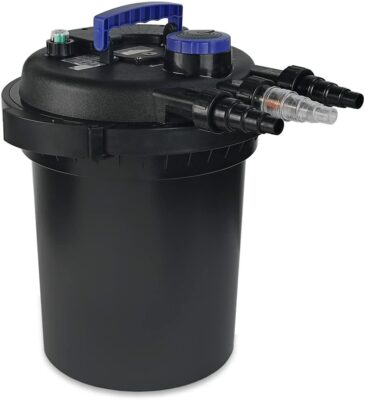
Editor’s Rating:
Why we like it: Built for big ponds with big needs, the XtremepowerUS is made to accommodate huge volumes of water with the same high-quality, crystal-clear filtration capabilities as other more well-known brands.
Quick Facts
- Type: Pressurized filter
- Capacity: 4000-gallon ponds
- Filtration stages:
- Includes: Filter and UV light; available filter, UV light, and pump kit
- Wattage: 13W UV light
Overall Performance
The most distinguishing feature of the XtremepowerUS Koi Pond Filter is its power. In fact, the complete pump and filter combo from this company are good for 4000-gallon ponds – perfect for extra-large setups with huge water circulation needs.
Features and Setup
Setup isn’t difficult at all, and the long power cord even makes the electrical part of the setup easier. It has 3/4″, 1″, 1-1/4″ and 1-1/2″ adaptors for inlets and outlets, and offers cleaning indicators and a backwash system that allows you to clean your media without having to open up the filter.
The pressurized water filter pushes water through 3 layers of special sponges that are good not only for mechanical filtration, but also as good growing places for colonies of beneficial bacteria. After that, the already filtered water passes through bio-balls that provide even more biological filtration. It’s also equipped with a 12W UV light that kills microorganisms that foul up your water.
Downsides
The biggest and perhaps only downside to this product is its durability. The build quality is rather flimsy. The housing, backflush, and indicators tend to break down after just several months of continuous use. It’s certainly a shame since there are very few good filter options for large ponds—your next best bet is the OASE BioSmart 5000, but its much more expensive.
Pros
- High-capacity
- Built-in UV light
- Multiple inlet/outlet adaptor sizes
- Easy set-up and maintenance
Cons
- Flimsy build
- Questionable product durability
7. Best Waterfall Filter: TetraPond Waterfall Filter
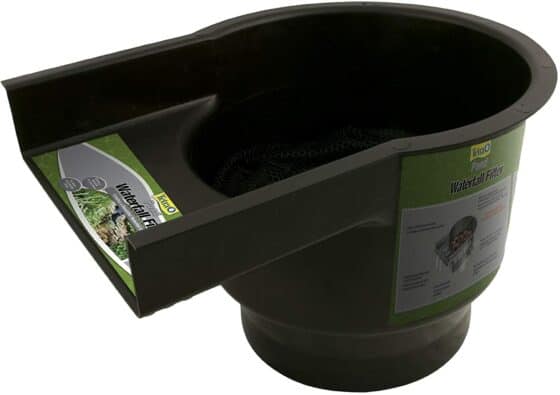
Editor’s Rating:
Why we like it: Tetra has long been one of the most trusted brands in the fishkeeping niche – not that it’s a surprise, considering this simple, sturdy and reliable TetraPond Waterfall filter that made it to this list.
Quick Facts
- Type: Waterfall filter
- Capacity: 500-4500 GPH
- Filtration stages: Mechanical, biological
- Includes: Filter only
Overall Performance
Made for small- to mid-sized ponds, the TetraPond Waterfall Filter is made to balance filtration with aesthetic abilities. Easy to assemble, clean, and maintain, this filter services your pond’s water to both mechanical and biological filtration, and even adds oxygenation to the mix.
Features and Setup
This waterfall filter’s simple and intuitive design makes it very easy to set up and maintain. For filtration media, it uses a fiber mat for mechanical filtration, and then through bags that contain lava rocks that is a good medium for biological filtration.
Design-wise, it’s also quite simple but still aesthetically pleasing. It can easily fit into any design that you’re trying to achieve with your pond, whether you want to hide it within rockscapes or behind plants and decorations. The filter also features an extra-long spillway to create its signature waterfall effect, with ridges to make it structurally sound.
Downsides
In terms of price-to-features ratio, this koi pond filter is rather disappointing. Compared to other similar products on the market, it offers much less for a much higher price. This is considering the fact that it doesn’t even come with a pump or a UV sterilizer. To add insult to injury, build quality is also doubtful, as there many reports of some parts breaking down after only months of usage.
Pros
- Nice waterfall effect
- Easy to set up and maintain
- Simple design
- Can be easily hidden
Cons
- Expensive
- Doubtful build quality
- No pump or UV sterilizer included
8. Best UV Sterilization Filter: Jebao CF-10 Pressured Pond Bio Filter
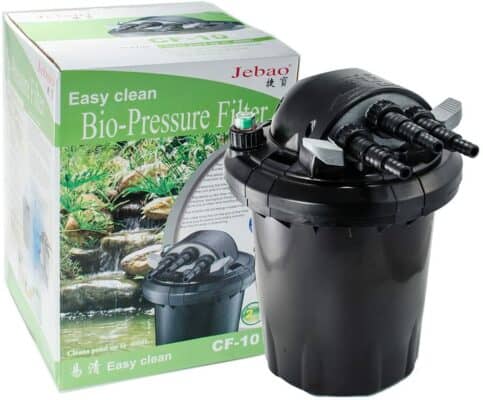
Editor’s Rating:
Why we like it: Capable of accommodating up to 1500 gallon koi ponds, the Jebao CF-10 a filter and sterilizer in one that is designed with small- to medium-sized ponds in mind.
Quick Facts
- Type: Pressurized filter
- Capacity: 1500-gallon ponds
- Filtration stages: Mechanical, biological
- Includes: Filter and UV light
Overall Performance
The Jebao CF-10 Pressured Pond Bio Filter is a good option if you have a small or midsize koi pond that needs some thorough cleaning. It comes with a UV sterilizer that can curb the growth of harmful bacteria and parasites.
Features and Setup
This unit is not difficult at all to set up. It also sports a backwash function that lets you clean the media without opening the filter and a cleaning indicator that tells you when you need to clean your filters out. It is colored in a nondescript way, and its compact design allows it to be nicely hidden in the landscape and design of your pond.
Its most distinguishing feature is the specially-designed UV penetration glass tube, made from quartz. The normal glass that most filters use cuts off the effectiveness of the UV light and doesn’t allow it to function to its full potential.
Not only is the quartz lamp more efficient in transmitting the UV light to the water, but the construction of the Jebao CF-10 also slows the water as it passes through and brings it closer to the UV lamp so that it maximizes the efficiency of the light in killing the microorganisms present in the water. In terms of filtration, it uses two foam disks that strain different levels of debris and support the growth of beneficial bacteria.
Downsides
If you have a pond that’s bigger than 1500 gallons, it’s best to look at other units such as the XtremepowerUS Bio Filter. Neither the UV light nor the filter itself is strong enough to keep that much volume of water clean. Although the setup isn’t too hard to figure out, the instruction manual is quite unclear so some users may encounter issues.
Pros
- Practical and compact design
- Relatively affordable price
- UV light maximization technology
- Ease of installation and maintenance
Cons
- Limited capacity
- Inadequate instruction manual
9. Best Pre-Filtration System: Aquascape Submersible Pond Water Filter
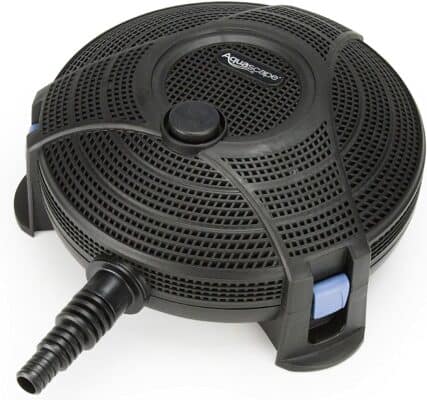
Editor’s Rating:
Why we like it: The Aquascape Submersible Water Filter is an improvement over the traditional prefilters, as it incorporates both mechanical and biological filtration media in a sleek, innovative design that prevents clogging.
Quick Facts
- Type: Prefilter
- Capacity: 800-gallon ponds
- Filtration stages: Mechanical, biological
- Includes: Filter only
Overall Performance
Technically, the Aquascape Pond Filter is a prefilter that fits in the intake of the attached pump. Water flows first to this filter before it is sucked into the pump and delivered to the outtake. As such, it has the common benefits of a prefilter, including providing mechanical filtration and preventing fish and other animals from being sucked in by the filter impellers.
Features and Setup
Although it’s a prefilter, it’s also much more than that. Prefilters typically only come in the form of a sponge filter, but this model comes with not only sponge filters for mechanical filtration, but also has ceramic rings for biological filtration.
It has a threaded, three-size adaptor that provides convenience when hooking up to the intake of the pump. The housing itself is also a removable cage for easy maintenance and an efficient cleaning process. The sleek, submersible design does not detract from the beauty of your pond and fish. The filter housing also has a large surface area, preventing it from clogging as often as typical models do.
Downsides
Although the Aquascape is pretty limited in its filtration capabilities, it’s still a nifty device capable of quality filtration. You may want to change the interior filter system, as the prefilter sponge may not be fine enough to collect smaller particles in the water. Also, there are only a few ceramic beads included in the kit, so keep that in mind if you want to use this for a long time.
Pros
- Compatible with a wide variety of pond pumps
- Easy installation with threaded, three-size adaptor
- Convenient maintenance
- Submersible and easily hidden
Cons
- Limited filtration capabilities
- Prefilter sponge may not be fine enough
- Only a little biological filtration included
10. Most Convenient Filter: Vivohome Bio Pressure Pond Filter
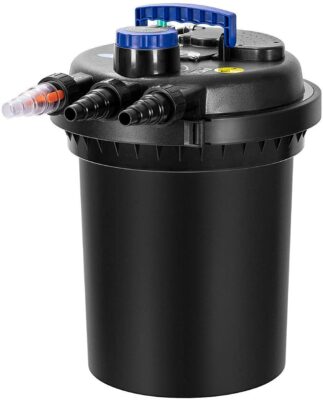
Editor’s Rating:
Why we like it: Ideal for mid- to large-sized ponds, the Vivohome does not offer anything new into the game – but that is to its credit because what it can do, it does very well.
Quick Facts
- Type: Pressurized filter
- Capacity: 800-1300 gallon ponds
- Filtration stages: Mechanical, biological, UV
- Includes: Filter and UV
Overall Performance
Focused on convenience and ease of use rather than looking good, the Vivohome Bio Pressure Pond Filter features different pipe adapters that make connections easier, cleaning indicators that tell you when to clean and a built-in filter cleaning system that makes it easy to clean the filter media with just the press of a button.
Features and Setup
When it comes to filtration, this filter features a two-zone sponge feature similar to GoPlus. The yellow sponge has a low density and promotes aerated bacteria, while the blue sponge has a high density and features anaerobic nitrifying bacteria.
The filter contains four replaceable filter sponges that keep the water clear and balanced. It also features a crank cleaning handle that allows you to clean the internal media just by turning it, without having to open and disassemble the filter.
Downsides
The unit is a bit more expensive compared to similar products on the market. It’s also a little bigger compared to typical pressure filters and may be more difficult to hide. The installation manual also contains inadequate information for installation, and parts are difficult to replace. Additionally, no pump is included, which is disappointing considering the price.
Pros
- Maintenance indicator
- Built-in cleaning crank handle
- Replaceable filter sponges
- Specialized filter media
- Removable UV light
Cons
- Installation instructions are lacking
- Hard-to-find replacement parts
- No pump included
The Ultimate Guide to Koi Pond Filters
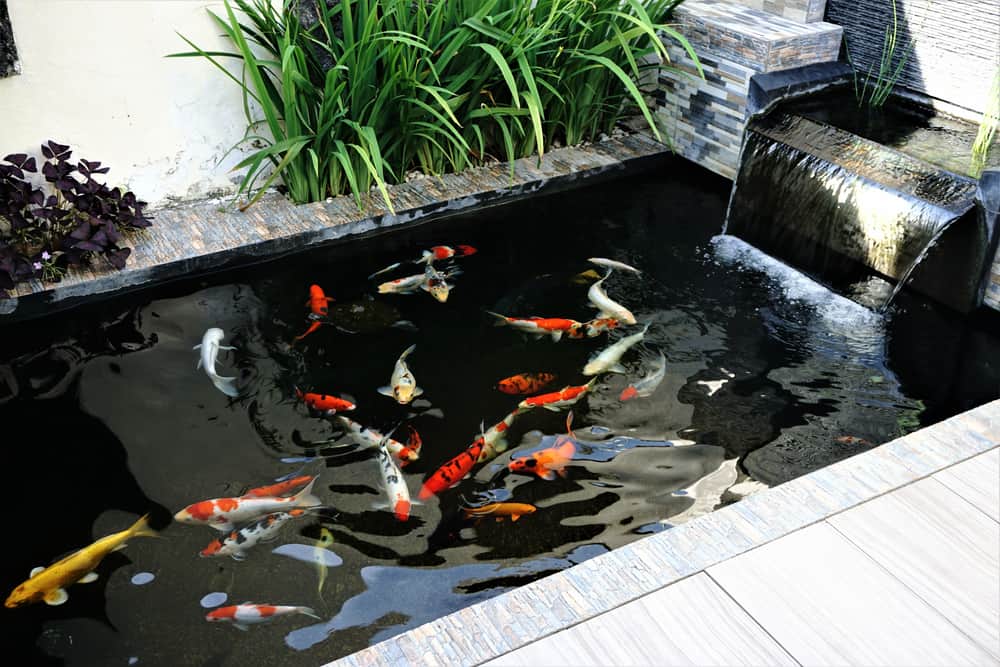
If you’re serious about creating a thriving, beautiful pond, then you should know that having ugly, stinky, stagnant water is far from being the first step to achieving your goal.
The answer to this dilemma is a pond filter. Having a filtration system is essential for any pond setups as not only does it keep the water clear and your beautiful koi fish visible, it also keeps your fish healthy.
In this section, we’re going to talk about everything you need to know when planning, buying, and maintaining your aquarium filters.
What Are Koi Pond Filters For?
The main purpose of a koi pond filter is to perpetuate the nitrogen cycle within your pond system. The nitrogen cycle is the process of degradation that happens to organic matter, and it is an ongoing, planet-wide process. However, it’s all the more crucial in bodies of water as it involves toxic chemicals that may harm the creatures living in them.
Without going into the technicalities, organic matter, such as fish poop and decaying aquatic plants, break down into toxic chemicals eventually. These toxic chemicals are further broken down by a variety of natural processes until the final output becomes harmless chemicals. In the vast nature, this process is carried out automatically.
But a man-made koi pond does not have the same properties that natural, life-sustaining ponds have. As a pond-keeper, you need to simulate this with the use of a pond filter. Instead of nature, your filter will have to do the breaking down process itself.
Benefits of Using Koi Pond Filters
Still not convinced that you need to get a koi pond filter? Here are some benefits to using one.
- Keeps your koi pond crystal clear. Filters remove the unwanted debris that eventually ends up on our little man-made body of water. As a result, you’ll be able to see your beautiful fish swimming in a glass-like lake, greatly improving the aesthetics and positive vibes of your setup.
- Keeps your koi fish healthy. Even the healthiest of fish can get sick due to dirty water. If you don’t have a filter, your fish could get poisoned or even killed by the harmful chemicals that build up in the water. Having a filter will prevent this from happening.
- Properly oxygenates the water in your pond. By reducing the presence of algae, your fish will have an easier time breathing in oxygen, something that’s absolutely necessary for their health.
- Simulates nature. In nature, koi fish love swimming in bodies of water that have a little flow to them. Filters provide this subtle flow. Your fish would certainly appreciate your pond’s mimicry of natural environments.
Types of Filtration
Filtration is better understood as stages of processing. As the water goes through these stages, they become cleaner and more fit for the fish to live in.
It’s important to know what happens during the filtration process and the stages of filtration because this is one of the main things that you will be looking at when choosing your pond filter unit.
Mechanical Filtration
Mechanical filtration is when debris and unwanted particles are filtered out of the water through the use of physical media. The filter media may trap large matters such as leaves, muck, or algae, or it may skim the water for smaller bits of waste. Common mechanical filter media are sponges, floss, or special mats that strain water as it passes through. These will need to be cleaned or replaced periodically to remove the muck that accumulates.
Mechanical filtration removes the dirt that clouds in your water, making it clear. However, this stage of filtration does not remove or process harmful chemicals present in your system. The water may be clear but it can still be full of toxins, as these substances are microscopic and invisible to the naked eye. You shouldn’t rely on mechanical filtration as the only form of filtration for your pond.
Chemical Filtration
This stage of filtration is when you use media with specialized chemical components, such as carbon or resins, to remove pollutants from the water. Filter media for this stage often comes in a pad, loose, or bagged form.
Unlike mechanical filtration, chemical filtration uses the physical properties of a substance to its advantage. This makes it very useful in purging specific substances from your pond’s water system, such as excessive ammonia or treatment and medicine applied to the pond.
Biological Filtration
This stage works by cultivating beneficial bacteria that thrive on the dangerous toxins present in the pond. These bacteria will be housed in porous, aerated substances where they can thrive and grow microscopic colonies of toxin-eaters that will convert the dangerous chemicals from fish waste, excess food, and other organic material in your pond into harmless forms.
Biological filters may also mechanically strain the water as well, as the water passes through the media bits and pieces of debris will also form. Due to this, some pond owners get away with using only biological filtration in their tanks.
Ultraviolet Clarifiers
Large bodies of nutrient-rich, sun-exposed water are the perfect breeding ground for green algae. These microorganisms thrive on excess nutrients found in the water and, although not necessarily harmful, make your pond look murky and unclean.
This is what ultraviolet clarifiers like those contained within our premium pick are for. Although not technically a filter, UV clarifiers are often used with a filter or are a part of the filter itself. UV light is deadly to not just algae, but other microorganisms present in the water as well. These organisms are usually already too small to be caught by mechanical filters, and so UV light is employed to kill these organisms and clarify the water. If you have an aquarium that you’d like to sterilize, you can take a look at our list of the best aquarium UV sterilizers.
Important Features of Pond Filters
Nowadays, pond filters are filled to the brim with lots of different features. If you’re a beginner pond-keeper with little knowledge about the subject, it may become overwhelming for you.
To sift through the unnecessary points, I’ve made this list of important features of pond filters that you should look at first. These are the core features of what makes a certain filter unit great – all the others come second to these.
Build Quality
Your pond filter is going to run 24/7, and the only time that it can rest is when there is a power outage or when it finally breaks down. That is a long time of heavy lifting for a little machine – no wonder most of them get damaged so easily. It’s a huge hassle when they do, as it will most likely create a huge mess. All the while, your pump is sitting there as toxins slowly pollute your beautiful koi pond.
When choosing a pond filter, make sure to buy units that put sturdiness and durability on the top of their list. This will ensure that your product will last for a long time. Also, try to buy from relatively well-known brands that come with easy-to-find parts. Should a replaceable part of the filter break, you shouldn’t need to turn over a haystack just to find your precious needle.
Flow Rate
Your filter’s flow rate should be able to completely cycle your pond’s entire volume at least once every hour. Choose a unit with the exact, or maybe even a little above, flow rate that you need to cover your pond’s volume by this amount.
Choosing a filter with the correct capacity will not only do wonders for your pond’s water quality but will also save you from expensive hassles down the line.
Cost and Warranty
Always choose filters with at least a year of warranty. Sometimes, products are delivered with factory damage or get harmed on the way – factors that you have no control over. In these unfortunate scenarios, you need to be able to get a different unit or at least get your money back. Not to mention, warranties are a symbol of confidence that the manufacturers have over their products.
Secondly, opt for filter units with realistic prices. This product is going to be a significant investment, and you are looking to use it for a long time. Don’t buy cheap knockoffs that you know will break after a few weeks. At the same time, if you don’t have the budget, don’t go for super expensive ones. Their features are often unnecessary and you’ll do just as well with reliable, mid-range brands. Our best budget pick, for instance, has all the features you need for a very affordable price.
Running Costs
Aside from the initial purchase, you also need to consider the electricity consumption of your filter unit every month.
Keep in mind that you’re going to be running this filter 24 hours a day, 7 days a week. This is going to add up to quite a significant amount of money, especially if your filter isn’t energy efficient. Remember, cheap filters are almost always going to cost more to run than high-powered, efficient ones.
Filter Kit Inclusion
Take note, not all filter systems are sold in a kit. Some come with a pump. Others come with a UV sterilizer. A few come with both, although some don’t even come with either one.
If you’re getting a product that only includes the actual filter unit, don’t be surprised at how much you might end up spending buying all the necessary media, containers, sterilizers, and more.
Kinds of Pond Filters
There are many kinds of pond filters to choose from, each with its own strengths and weaknesses. In this section, let’s examine what these are and in what setups they are ideal for.
Pre-Filters
This kind of filter is more commonly seen among small, 100-500 gallon ponds, but can be applied to setups of any size. Prefilters are usually sponge filter-boxes that are located underwater in the center of the pond, hooked to the pump’s intake.
These filter boxes are designed to screen solid waste before they reach and do damage to the impellers or clog the biological filters situated further inside the filter unit. They also act as barriers that help pond fish and other animals avoid getting sucked into the filter.
Pond Skimmers
The primary purpose of a pond skimmer is to remove all the debris and unwanted material that may fall onto the water’s surface before it sinks to the pond bottom and turns into dirty, smelly muck.
Skimmer filters are installed just on the outside of the pond-liner, at the water level. They continually suck in the surface water and strain the debris to eliminate unwanted objects before they decompose into toxic chemicals. These kinds of filters are effective, and even prescribed, to maintain the water cleanliness of the pond, regardless of the volume.
Pressure Filters
Pressure filters are mechanical filters that force water through a filter medium to collect unwanted particles and debris. They are more flexible in their usage compared to other types of koi pond filters.
Because these filters are pressurized, the container that houses the pump and the medium can be significantly smaller than non-pressurized filters. This means that one can easily hide pressurized filters in the surrounding landscape. They can even be buried in the ground or submerged in water.
Pressure filters work well with surface skimmers – the latter takes care of the surface-level debris, while the former eliminates deeper-set debris.
Waterfall Filters
Although they can also be used in different-sized ponds, waterfall filters are more often seen in small to medium-sized ponds. These units typically contain biological and mechanical filtration media. As a small bonus, they also provide good aeration for your koi pond water.
The main distinguishing feature of this kind of filter is the fact that they’re also designed to improve your pond’s aesthetics. Water typically flows off from the filter and into the surface of the pond like a waterfall. Because of this, waterfall filters like the CNZ Pond Filter and the TetraPond Waterfall Filter typically need to be placed above the water level of the pond.
UV Sterilizers
Although not actually a filter, UV sterilizers are important for pond water quality management. This is because UV sterilization has been proven to be the most efficient and safest way of eliminating and preventing green algae in the pond. UV light also kills other microscopic organisms in the water, such as bacteria, viruses, and fungi.
This results in clear and healthy water, so although it technically doesn’t filter water, it is still used in conjunction with, and even as a part of, pond filter systems.
Getting the Best Koi Pond Filter
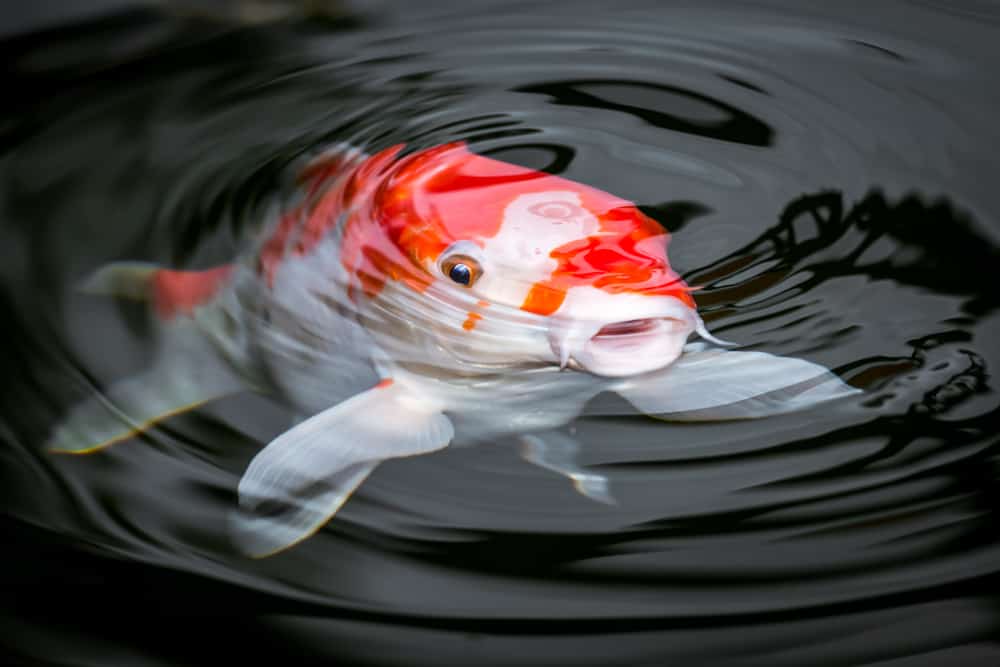
A koi pond filter is a crucial piece of hardware for anyone planning to start a koi pond. When looking for a filter, check out its most important features: its build quality, flow rate, initial cost, running cost, warranty, and what’s included in the kit.
With that, you can now enjoy your crystal clear koi pond! And while you’re treating your koi to the best, you might want to consider picking up some high-quality koi food — just like filters, they’re not all created equal, so it’s worth spending the time to find the right one.
